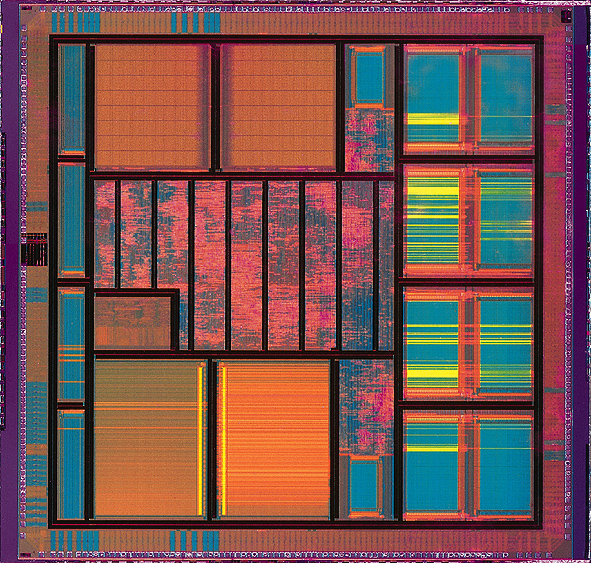The study of digital circuits has driven the rapid development of digital devices. Digital devices can be classified by scale according to their different purposes and methods, or they can be classified according to their uses and characteristics.
1.Digital Devices Can be Classified by Scale
- Small-scale digital devices (SSI, tens of devices per chip): including gate circuits, flip-flops, counters, etc., used for the design of small-scale integrated circuits. such as gate circuit series (74LS00)
- Medium-scale digital devices (MSI, hundreds of devices per chip): including multiplexers, decoders, encoders, etc., used for the design of medium-scale integrated circuits. such as arithmetic logic units, counters, etc.
- Large-scale digital devices (LSI, thousands of devices per chip): including microprocessors, memories, logic units, etc., used for the design of large-scale integrated circuits.such as early CPUs like INTEL’s 8088, MCS-51, FLASH memory, etc.
- Very large-scale digital devices (VLSI, more than ten thousand devices per chip) : including modern microprocessors, graphics processors, digital signal processors, etc., used for the design of very large-scale integrated circuits. such as X86 series, ARM series CPUs, etc.
Although digital devices can be classified into the above four categories by scale, the scale of large-scale and very large-scale devices is also constantly changing due to the rapid development of digital devices.
2. Digital Devices Can be Classified by Usages
- General-purpose devices: such as gate circuits, triggers, general-purpose CPUs, GPUs, general-purpose memory, etc.
- Application-specific devices (ASIC): ASIC (Application Specific Integrated Circuit) is a type of custom circuit designed for specific applications. As ASIC is designed with the application and functional characteristics in mind, it is generally optimized for cost, computational power, power consumption, and other professional parameters, and thus has excellent performance in specific fields. However, the downside is that it has little or no use outside of the specific field, hence the name “special-purpose ASIC”. Examples of ASICs are specialized image processing chips, speech processing chips, etc.
- Field-programmable gate arrays (FPGA): FPGAs are programmable logic devices that are reconfigurable in the field. They are semi-custom or non-customized devices that can be programmed to perform specific functions. Although FPGAs offer a high degree of flexibility, they are generally more expensive and consume more power compared to ASICs when implementing the same functions.
General-purpose devices can be classified into the following categories:
- Memory devices: used for data storage, such as RAM, ROM, Flash, EEPROM, etc.
- Arithmetic devices: used for processing and calculation of digital signals, such as ALUs, adders, multipliers, dividers, etc.
- Control devices: used to coordinate the work of various parts in a digital system, such as timers, counters, triggers, etc.
- Digital signal converter devices: used for conversion and processing of digital signals, such as analog-to-digital converters (ADCs), digital-to-analog converters (DACs), etc.
- Digital signal processing devices: used for filtering, modulation, demodulation and other processing of digital signals, such as DSP chips, etc.
- Communication devices: used for digital communication systems, such as modems, optical modules, Ethernet chips, etc.
- Display devices: used for digital display systems, such as LED digital tubes, LCDs, OLEDs, etc.
- Sensor devices: used in measurement and control systems, such as pressure sensors, temperature sensors, humidity sensors, etc.
- Special-purpose devices: used for specific digital systems or specific application scenarios, such as calculator chips, smart card chips, etc.
3. Digital Devices Can also be Classified by the Manufacturing Process
Digital circuits can be divided into two types: bipolar (TTL type) and unipolar (MOS type).
- Bipolar TTL: TTL (Transistor-Transistor Logic) is an integrated circuit composed of bipolar transistors, typical of early small-scale integrated circuits in the 74 series, such as 74LS00, 74LS85, etc. However, due to the rapid development of CMOS circuits, later medium- and large-scale integrated circuits are mainly produced using CMOS technology.
- Unipolar MOS: MOS (Metal-Oxide-Semiconductor) is an integrated circuit composed of metal-oxide-semiconductor field-effect transistors. CMOS (Complementary MOS) is a complementary MOS technology. Information about MOS and CMOS can be found in the introduction to analog electronic technology, CMOS analog integrated circuits, and CMOS digital integrated circuits.
4. Digital Circuits Can be Classified According to Their Structure and Working Principle
Digital circuits can be classified according to their structure and working principle. The common classifications are as follows:
- Combinational logic circuit: It consists of multiple logic gate circuits, and the circuit’s output is only related to the input signals and not affected by timing factors. It is commonly used to implement Boolean logic operations, data selection, and encoding functions. They do not have any memory function and their output signal only depends on the current input signal, not on any previous state of the circuit. The input-output relationship is purely logical.
- Sequential logic circuit: It consists of combinational logic circuits and flip-flops (or latches), and the circuit’s output is not only related to the input signals but also affected by timing factors. It is commonly used to implement storage, counting, and timing control functions. It has a memory function, and its output signal is not only related to the current input signal but also related to the previous state of the circuit, which means it remembers the previous state in time and participates in the current operation.
- Random logic circuit: It consists of multiple nonlinear components (such as diodes, transistors, etc.), and the circuit’s output signal is not only related to the input signal but also affected by random noise. Random logic circuits are usually applied in fields such as random number generators and cryptography.
- Digital signal processing circuit: It consists of multiple digital signal processors (DSPs) and is used to process digital signals, such as filtering, transformation, compression, etc.
- Other types: There are also some special digital circuits, such as computer memory, digital signal generator, digital television, etc.
